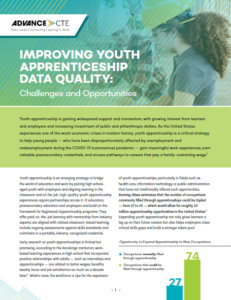 Apprenticeship in the United States is an under-utilized but promising education and employment strategy — particularly for youth whose connections to college and paid work are even more tenuous due to the COVID-19 economic crisis. In 2018, New America launched the Partnership to Advance Youth Apprenticeship (PAYA), a national network of partners (including Advance CTE), states, local intermediaries and philanthropies to define and scale up high-quality youth apprenticeships nationwide. In just a couple short years, the network has made incredible progress, sowing the seeds for future programs.
Apprenticeship in the United States is an under-utilized but promising education and employment strategy — particularly for youth whose connections to college and paid work are even more tenuous due to the COVID-19 economic crisis. In 2018, New America launched the Partnership to Advance Youth Apprenticeship (PAYA), a national network of partners (including Advance CTE), states, local intermediaries and philanthropies to define and scale up high-quality youth apprenticeships nationwide. In just a couple short years, the network has made incredible progress, sowing the seeds for future programs.
But through all of this work, data quality has emerged as a persistent challenge for states as well as local intermediaries. Improving the quality and availability of youth apprenticeship data can help PAYA network partners evaluate program quality, address gaps in equitable access and outcomes, and make the case for further investment in youth apprenticeship. But building the infrastructure to collect, validate, warehouse and analyze youth apprenticeship data can be costly and time intensive.
To dig deeper into this challenge, Advance CTE and New America organized a practitioner workgroup on youth apprenticeship data quality in early 2020. The workgroup met several times throughout 2020 to discuss the following questions:
- What common challenges do states and intermediaries face in collecting, validating and using youth apprenticeship data?
- What are effective strategies to build a high-quality youth apprenticeship data infrastructure at the state and local level?
The workgroup’s conclusions are summarized in a new report, Improving Youth Apprenticeship Data Quality: Challenges and Opportunities. The report addresses five challenges with improving youth apprenticeship data quality and several promising strategies to mitigate data roadblocks:
- Determining what to measure: Some states have taken the guesswork out of data collection by establishing statewide business rules for collecting youth apprenticeship information. But in others, local intermediaries are left to their own devices, leading to inconsistencies in how youth apprenticeship data is collected. State and local leaders should work to develop and adopt consistent definitions and business rules for collecting for youth apprenticeship data.
- Clarifying roles and responsibilities: Another challenge is clarifying who is collecting what data in the first place. Because youth apprenticeship involves partnerships across the K-12, postsecondary and workforce systems — with state agencies, intermediary organizations and employers in the mix — clarifying roles and responsibilities for collecting and sharing data early on is important. Local intermediaries can coordinate this process, ensuring all partners are aware of their responsibilities.
- Building the infrastructure: Collecting and warehousing data can require costly technology. Building out an entire data system before launching a new youth apprenticeship program might not be feasible, but state and local leaders should establish systems and processes at the beginning that can be scaled easily. They can also leverage existing systems — such as student information systems housed at the school district or college — or develop new tools to minimize the data collection burden on educators and employers.
- Accessing data: Privacy rules, data transfer limitations and incompatible data systems can, at times, limit access to data for youth apprenticeship participants. To ensure that all relevant partners can access the data they need, intermediary organizations should establish data sharing agreements that specify what information will be shared and in what format as well as the process and frequency for sharing this information. States can facilitate this process by developing local data sharing templates and demystifying rules and regulations for data sharing.
- Scaling and sustaining: Finally, the workgroup elevated challenges with bringing data collection processes to scale as youth apprenticeship programs expand statewide. State leaders play an important role in supporting the sustainability and scale of youth apprenticeship programs by streamlining data collection processes, integrating youth apprenticeship data into existing state databases, providing sustainable funding, and offering professional development opportunities to build the capacity of frontline actors.
Data is rarely among the first priorities in setting up a new youth apprenticeship program, but it should be. With reliable and valid youth apprenticeship data, states and local intermediaries can help scale quality programs that expand college and career options for high school students and meet the training needs of employers and industry.. The report Improving Youth Apprenticeship Data Quality: Challenges and Opportunities outlines the most common barriers to improving youth apprenticeship data quality and provides actionable recommendations for states and local intermediaries to strengthen the reliability, validity and use of their data.
Austin Estes, Manager of Data & Research, Advance CTE
Tags: Data, PAYA, youth apprenticeship

